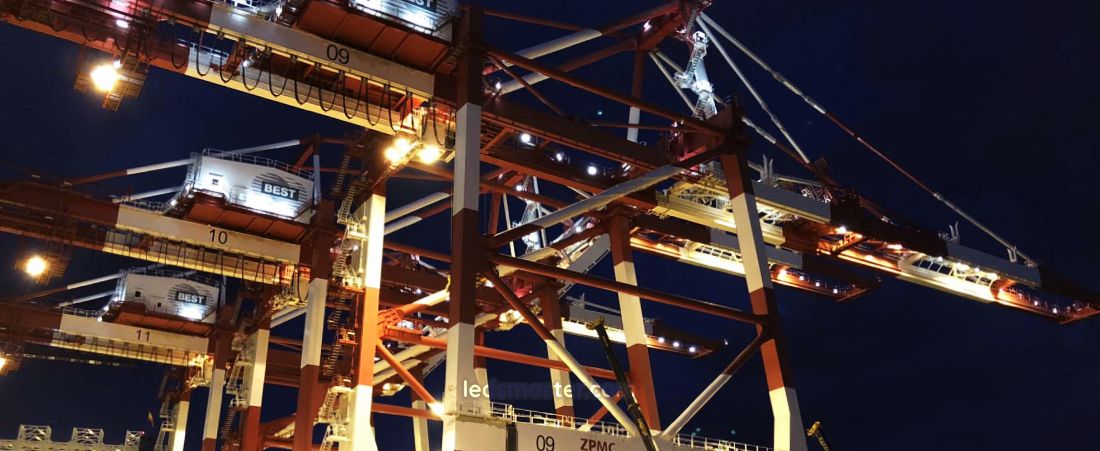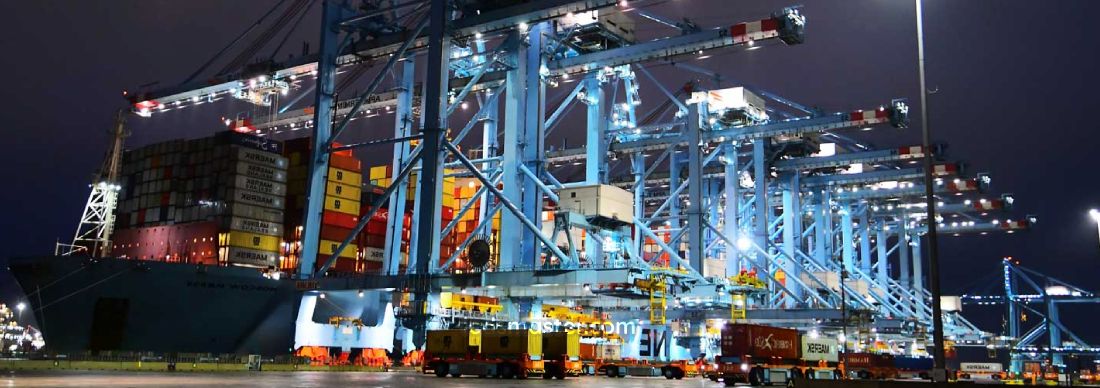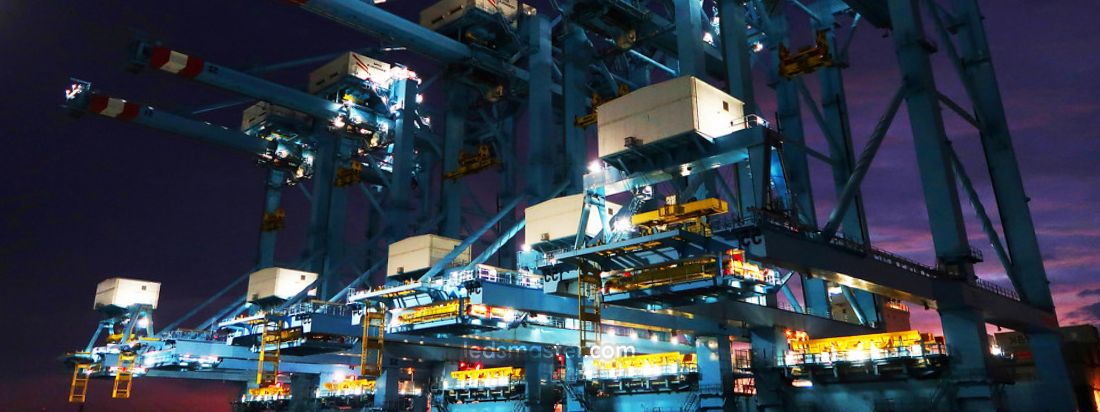
When it comes to crane operations, effective lighting is not just about visibility—it’s a key factor in safety, efficiency, and productivity. Whether lifting heavy loads or performing delicate tasks, the right lighting ensures operators can work with confidence and precision.
Get your complimentary lighting design today
Cranes are commonly used in harsh environments where exposure to dust, moisture, and temperature variations is frequent. As such, selecting the right lighting system that can withstand these challenges while maintaining high visibility is imperative. Furthermore, lighting affects the operational environment by improving visibility, reducing errors, and enhancing the overall effectiveness of crane tasks. This design process involves various factors, such as the type of lighting fixtures, placement, energy efficiency, uniformity, and the environment in which the crane operates.
Table of Contents
ToggleWhen selecting lighting fixtures for cranes, it is crucial to consider the environment in which the crane operates. LED lighting is becoming the standard choice for crane applications because it offers energy efficiency, long lifespan, and high brightness. Unlike traditional lighting types, LEDs consume less power, require less maintenance, and provide higher light output, making them ideal for industrial settings. While halogen and metal halide lights are still used in some situations, they tend to have shorter lifespans and lower efficiency compared to LEDs. They can, however, be beneficial for certain tasks that require higher color rendering for visual accuracy.
Proper mounting of lighting fixtures on cranes is vital to ensure the illumination is directed where it’s needed. Lighting systems are typically mounted on brackets fixed to crane structures, such as beams or arms. These brackets must be durable enough to handle vibrations and movement while providing flexibility for light adjustments. In modern cranes, lighting is sometimes integrated directly into the crane’s structure, providing a more streamlined design and ensuring the lights are positioned optimally.
Because cranes are dynamic machines, their lighting systems need to be adaptable. Adjustable fixtures that can rotate or tilt allow the light to follow the movement of the crane, ensuring consistent illumination across the workspace. These adjustable features are especially helpful in situations where the crane is lifting heavy loads or moving in different directions, as they help maintain the necessary visibility.

Cranes often operate in environments where exposure to dust, moisture, and extreme temperatures is inevitable. To ensure longevity and consistent performance, the lighting fixtures must be designed to withstand these environmental conditions. Dust, in particular, can clog fixtures and reduce light output, while exposure to water or extreme temperatures can lead to fixture failure. By selecting lighting systems that offer protection against these elements, crane operators can reduce maintenance costs and increase the lifespan of their equipment.
To address concerns related to dust and water, crane lighting fixtures must have a high IP rating. The IP rating system classifies the level of protection a fixture has against the ingress of solids and liquids. Fixtures rated IP65, IP66, or IP67 are commonly used for crane operations. These ratings ensure that the lights are dust-tight and capable of withstanding water exposure, making them suitable for outdoor and industrial environments.
In addition to dust and water resistance, the materials used in crane lighting must also be resistant to corrosion. Cranes often operate in environments where they are exposed to harsh chemicals, saltwater, or extreme weather conditions. Materials like stainless steel or anodized aluminum are frequently used for the housing and brackets of lighting systems due to their corrosion-resistant properties, ensuring that the fixtures continue to function effectively over time.
Lux refers to the amount of light that reaches a specific area, and it is a critical factor in crane lighting design. Adequate lux levels are essential for ensuring that crane operators have sufficient visibility to perform tasks accurately and safely. The lux requirement for crane operations varies based on the type of crane and the tasks being carried out. For general lifting tasks, a lux level of 200-300 is often sufficient. However, tasks that demand higher precision, such as handling fragile items, may require lux levels of 500-750.
| Task Type | Lux Required | Application |
|---|---|---|
| General Lifting | 200-300 lux | Standard lifting and moving tasks |
| Precise Handling | 500-750 lux | Handling delicate items or high-accuracy tasks |
| Special Applications | 1000 lux | Detailed inspection or intricate operations |
Several factors determine the necessary lux levels for crane operations. The type of environment plays a significant role, with indoor cranes often requiring lower lux levels than outdoor cranes due to ambient light conditions. Additionally, the complexity of the task being performed is a key consideration. More intricate tasks, such as precise load positioning or operations involving hazardous materials, require higher lux levels to ensure adequate visibility. Environmental factors like changing light conditions and weather conditions can also influence the lux requirements, as they can reduce visibility and necessitate additional lighting.
In crane operations, lux levels must meet industry standards to ensure safety and proper functionality. Organizations such as ISO and OSHA provide guidelines for lighting in industrial environments, including minimum lux levels for specific tasks. These standards help ensure that lighting systems are adequately designed to meet the visual needs of operators and prevent accidents or errors due to poor illumination.

Uniformity in lighting is essential for crane operations. Uneven lighting can create shadows or overly bright spots that hinder visibility and make it difficult for operators to navigate or position loads accurately. Shadows can be particularly dangerous as they may conceal obstacles or areas where visibility is essential. Uniform lighting ensures that every part of the workspace is adequately illuminated, reducing the risk of accidents and improving the operator’s ability to judge distances and handle loads efficiently.
Achieving uniform light distribution requires careful planning of fixture placement. The positioning of lighting fixtures should be spaced in a way that ensures their beams overlap, filling in any gaps in light coverage. The use of diffusers, reflectors, and secondary optics can further enhance light uniformity. Diffusers help spread light more evenly, reducing harsh shadows and bright spots, while reflectors direct light towards areas that may otherwise be poorly lit. Secondary optics, such as lenses, can also help distribute light more evenly across the workspace.
| Uniformity Ratio | Minimum Recommended Ratio | Application |
|---|---|---|
| Uniformity | 0.7 | Standard crane operations, general visibility |
| High Uniformity | 0.8-0.9 | Tasks requiring high precision and minimal shadows |
As cranes are dynamic machines, the lighting system must account for their movement. Adjustable lighting fixtures are ideal in such cases, as they can move with the crane and ensure consistent illumination, regardless of its position. Whether the crane is rotating, tilting, or moving along a track, adjustable lights help ensure that the work area remains well-lit, even when the crane is in motion.
The color temperature of crane lighting affects visibility and the operator’s ability to distinguish objects in the work area. Color temperature is measured in Kelvins (K) and ranges from warm (low Kelvin) to cool (high Kelvin) light. For crane operations, cooler color temperatures, typically between 5000K and 6500K, are preferred because they resemble natural daylight and provide clear, high-contrast visibility. This is especially important in outdoor environments where natural light can be inconsistent or insufficient.
While cooler color temperatures are generally preferred for crane operations, warmer lights with color temperatures between 3000K and 4000K are sometimes used in indoor settings. Warmer lights are softer and can create a more comfortable atmosphere, but they may not provide the same level of contrast and clarity as cooler lights. For tasks that require precise visibility, such as handling delicate materials or working in low-visibility conditions, cooler color temperatures are typically the better choice.
In addition to color temperature, the Color Rendering Index (CRI) is an important factor in selecting lighting. The CRI measures how accurately light reveals the true colors of objects, and a higher CRI ensures that materials are seen in their true hue. A higher CRI (above 80) is particularly beneficial for tasks where accurate color identification is necessary.
| Color Temperature | Range (Kelvins) | Light Characteristics | Recommended Use Case |
|---|---|---|---|
| Cool Light | 5000K – 6500K | High contrast, daylight-like illumination | Outdoor cranes, tasks requiring high visibility |
| Neutral Light | 4000K – 5000K | Balanced, white light | General indoor crane operations |
| Warm Light | 3000K – 4000K | Softer, warmer illumination | Indoor environments, comfort lighting |
Energy efficiency is a key consideration in crane lighting design, as it directly impacts operational costs. Since cranes are often in operation for extended periods, lighting systems that use less energy can significantly reduce electricity consumption. LED lights are particularly advantageous in this regard, as they provide high brightness with low energy usage. They also have longer lifespans compared to traditional lighting options like halogen and metal halide, which means less frequent replacements and reduced maintenance costs.
In addition to being energy-efficient, crane lighting systems are increasingly being designed with sustainability in mind. Using recyclable materials for lighting fixtures and employing renewable energy sources like solar power can reduce the environmental impact of crane operations. Solar-powered lighting systems are particularly useful in remote locations or off-grid environments, where access to the electrical grid is limited. These systems can reduce dependence on traditional power sources and contribute to a greener, more sustainable approach to industrial lighting.

Maintaining crane lighting systems is crucial for ensuring their continued performance. Regular cleaning and inspection of fixtures can prevent issues such as dust buildup, which can reduce light output. It is also important to check the electrical components for signs of wear or damage. Proper maintenance helps extend the lifespan of lighting systems and ensures that they continue to perform effectively.
| Fixture Type | Lifespan (Hours) | Maintenance Interval | Replacement Frequency |
|---|---|---|---|
| LED Fixtures | 50,000 – 100,000 hours | Every 3-6 months (cleaning and inspection) | Rarely needed, around 8-10 years |
| Halogen Fixtures | 2,000 – 3,000 hours | Every 3-6 months (bulb replacement) | Every 6-12 months |
| Metal Halide Fixtures | 10,000 – 15,000 hours | Every 12 months (bulb and ballast inspection) | Every 1-2 years |
Designing crane lighting systems for durability is important to reduce maintenance needs and extend the life of the fixtures. Using corrosion-resistant materials, such as stainless steel or anodized aluminum, helps protect the fixtures from damage caused by exposure to chemicals, moisture, or extreme temperatures. High-quality LEDs are also designed to last longer than traditional light sources, and their long lifespan reduces the frequency of replacements. Additionally, modular designs allow for easier repairs or component replacements without needing to replace the entire system.
In conclusion, crane lighting design requires careful consideration of various factors to ensure efficiency, safety, and durability. By focusing on the right fixtures, placement, energy efficiency, lux levels, uniformity, and environmental resistance, crane operators can enhance both productivity and safety. Additionally, the longevity and sustainability of the lighting system contribute to reduced operational costs and less environmental impact, making effective crane lighting a key component of modern industrial operations.
| Material Type | Corrosion Resistance | Expected Lifespan | Use Case |
|---|---|---|---|
| Stainless Steel | Highly resistant to rust and corrosion | 10-15 years | Harsh outdoor environments, saltwater exposure |
| Anodized Aluminum | Excellent corrosion resistance | 5-10 years | Indoor cranes, light-duty outdoor environments |
| Plastic Coatings | Moderate resistance to corrosion | 3-5 years | Mild indoor and dry environments |
Key factors such as fixture type, mounting options, light distribution, and environmental protection must be carefully considered. LED fixtures, with their energy efficiency and long lifespan, are the preferred choice for most crane operations. Proper lux levels and uniformity improve visibility, while color temperature affects worker comfort. Additionally, selecting fixtures with appropriate IP ratings ensures durability in harsh conditions. By prioritizing these elements, crane lighting systems can offer reliable performance, reduce energy costs, and enhance safety across various tasks.